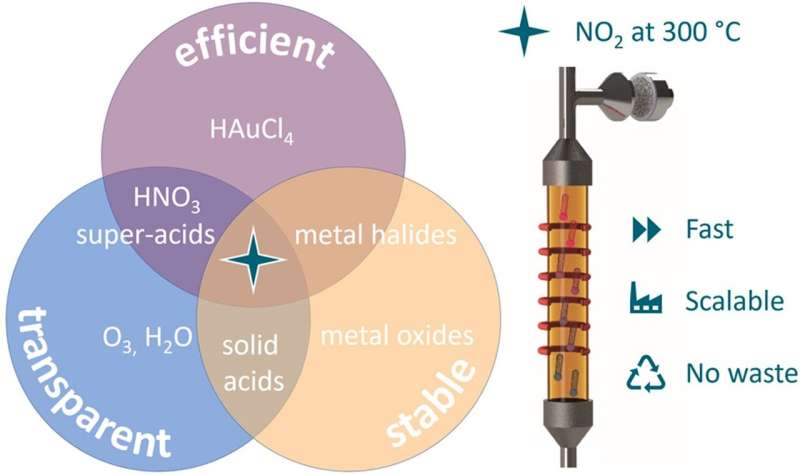This article has been reviewed according to Science X's editorial process and policies. Editors have highlighted the following attributes while ensuring the content's credibility:
fact-checked
peer-reviewed publication
trusted source
proofread
Nasty pollutant shown to be the missing ingredient for carbon nanotube films for touchscreens and solar cells

Skoltech scientists have proposed a fast, scalable, wasteless chemical treatment technique for endowing carbon nanotube films with all the right properties to improve the performance of solar panels, touchscreens, and more.
Reported
in Carbon, the team's experiments show that exposure to even small amounts of nitrogen dioxide gas at elevated temperatures modifies
Carbon nanotube films conduct electricity and let light through, making them an excellent material for transparent electrodes. These are essential for solar cells and touchscreens, which used to rely on the brittle and unsustainable indium tin oxide films and other conventional materials.
As of today, carbon nanotubes doped with additional atoms of other elements provide better conductivity and transparency, as well as bending capacity for flexible devices.
"Doping is very crucial here. Unfortunately, current technology does not permit the manufacture of carbon nanotubes that would have the necessary characteristics in their pure form. That said, there are a range of doping agents that alter nanotube properties. Depending on which chemical is used, one can make the film either highly conductive or transparent or stable. With some luck, you could have two of these three attributes. We managed to combine all three," said the study's principal investigator Professor Albert Nasibulin from the Photonics Center.
One common doping agent is hydrogen tetrachloroaurate, for example. It offers peak performance in terms of nanotube electrical conductivity, along with reasonably good transparency. However, this modification is rather unstable, so the effect wears off quickly.
Copper bromide and other metal halides provide a decent combination of stability and conductivity, but the transparency is poor. Similar trade-offs are involved with any chemical used for carbon nanotube doping today.
"We found a solution that does good on all counts. Our doping agent is a gas called nitrogen dioxide, occasionally referred to as 'fox tail' for its bright orange color. In fact, we were investigating another, rather unstable modification this gas causes when nanotubes are exposed to it at much lower temperatures," study co-author Assistant Professor Dmitry Krasnikov added.
"Sort of by accident, we stumbled upon a different range of temperatures where the resulting modifications are highly stable. A further benefit of working with a gas-phase agent is that it makes the doping technology fast, scalable, and wasteless. Indeed, nitrogen dioxide will be easy to integrate into existing technological processes, and it is easy to remove from the reactor, because it turns to liquid once cooled to 20 degrees Celsius."
According to the study, over the course of one year, the effect of the new doping suffers a mere 1.5 times degradation within a short period of time, followed by a stable plateau, compared with three times drawn out over an extended period for the current champion tetrachloroaurate.
The new agent's effect on conductivity is comparable to tetrachloroaurate's, and better than that of any other agent. The transparency is good, too: Being a gas, nitrogen dioxide seems to avoid multilayer adsorption to carbon nanotube films providing an exclusively molecular-thick layer. Unlike solid agents—including tetrachloroaurate—no additional particles settle on top of those previously deposited.
The team hopes that transparent carbon nanotube-based electrodes doped with nitrogen dioxide will soon make their way into photovoltaic elements, touchscreens, and other interactive surfaces in homes, cars, or public spaces. Such electrodes would also be biologically compatible, so they could find applications in implantable devices.
Optical components, such as the varifocal Fresnel zone plate for harnessing terahertz radiation in 6G communication and X-ray-free medical imaging and security scans, would also benefit from the improved characteristics of carbon nanotube films, achieved with the new doping agent.
More information: Eldar M. Khabushev et al, High-temperature adsorption of nitrogen dioxide for stable, efficient, and scalable doping of carbon nanotubes, Carbon (2024). DOI: 10.1016/j.carbon.2024.119082
Journal information: Carbon
Provided by Skolkovo Institute of Science and Technology




















